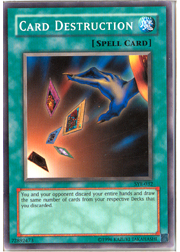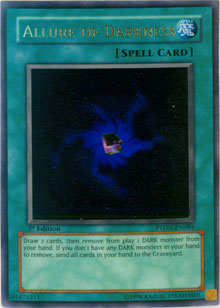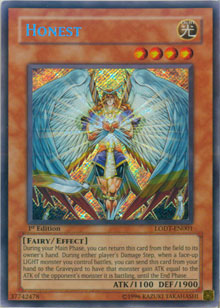 Simple cards are always tricky to write about. On one hand, some of the best cards in the history of the Yu-Gi-Oh! TCG have been very simplistic: Pot of Greed, Heavy Storm, Cyber Dragon, Scapegoat, Torrential Tribute . . . the list goes on. At the same time though, good simple cards are usually obvious, and they tend to see constant play unless they happen to be Forbidden. Usually there isn’t much reason for me to discuss them because their virtues are so easy to see.
Simple cards are always tricky to write about. On one hand, some of the best cards in the history of the Yu-Gi-Oh! TCG have been very simplistic: Pot of Greed, Heavy Storm, Cyber Dragon, Scapegoat, Torrential Tribute . . . the list goes on. At the same time though, good simple cards are usually obvious, and they tend to see constant play unless they happen to be Forbidden. Usually there isn’t much reason for me to discuss them because their virtues are so easy to see.
However, once in a blue moon a simple card comes along that, despite being obviously good, isn’t seeing the play it deserves. This is a cyclical game: a potentially powerful card may be great at one time but not worth playing in another, depending on trends and metagame shifts. Card Destruction is a strong example of that: it’s a simple card that can have a big impact, but it’s never seen much play because it costs a card to activate (you lose Card Destruction itself). In most previous formats that was enough to keep it off the tournament tables.
But now, in a format where having the right cards is sometimes more important than having more cards, the doors are wide open for Card Destruction to see tournament play. What I’m suggesting isn’t an original idea: we’ve seen duelists like Arthur Rogers and Erin Diaz take this card to Day 2 in recent Shonen Jumps with Lightsworn variants. What’s intriguing though, is that the card fits into so many other strategies.
There are three reasons this is a good card right now: all three are simplistic, but together they make a compelling argument for this card’s viability. Let’s look at each.
Acceleration
 Acceleration is the ability to sift through cards until you find the ones your deck wants to see the most. In the past few years, the most successful decks have usually been the ones with superior acceleration: Lightsworn have Solar Recharge and Charge of the Light Brigade, while TeleDAD has Allure of Darkness and Destiny Draw: all cards that offer acceleration as a reward for adhering to a particular strategy. On the other side of the fence, Morphing Jar, Cyber Jar, and even Foolish Burial coupled with graveyard recursion have provided the same jolt of speed to other decks without demanding specific requisites.
Acceleration is the ability to sift through cards until you find the ones your deck wants to see the most. In the past few years, the most successful decks have usually been the ones with superior acceleration: Lightsworn have Solar Recharge and Charge of the Light Brigade, while TeleDAD has Allure of Darkness and Destiny Draw: all cards that offer acceleration as a reward for adhering to a particular strategy. On the other side of the fence, Morphing Jar, Cyber Jar, and even Foolish Burial coupled with graveyard recursion have provided the same jolt of speed to other decks without demanding specific requisites.
The latter is exactly what Card Destruction offers: a perfectly generic way to peel through as many cards as you have in your hand, regardless of what you play. It costs a card to activate and it’s only as good as the number of in-hand cards you have—that means its efficiency diminishes over the course of most games (because you naturally play cards as turns pass). But in the first several turns of a duel it’s easy to use Card Destruction and see four more cards than you would without it. Even to an acceleration-heavy deck like TeleDAD, that’s an advance of two turns or more through your deck’s contents. In a strategy that doesn’t have a "draw 2" card, it’s three or four turns of card sifting—it’s hard to emphasize how good that is when many games only last three or four turns in the first place.
In addition, Card Destruction lets you trade dead cards for live ones. Don’t need that Monster Reincarnation right now? Drew Lightning Vortex and all your opponent has out is Elemental Hero Stratos or Sangan? Card Destruction lets you trade cards you don’t want right now for cards you might want, getting you out of situations where you may have no choice but to play conservatively and wait for cards to come online.
Graveyard Utility
Taking that lost thought even further, perhaps the real driving force behind Card Destruction’s newfound viability is the fact that there are so many cards worth loading into your graveyard. TeleDAD can fill up on Dark monsters while pitching Destiny Hero - Malicious. Lightsworn can load their yard with monsters to feed Judgment Dragon, as well as Necro Gardna. Zombies can drop Mezuki for its effect, while also prepping the graveyard for Zombie Master and Il Blud. All three can benefit from putting Plaguespreader Zombie into the graveyard too, and while Card Destruction comes with the same initial one-card loss Dark Grepher demands, it will often be easier to play and won’t leave you with a vulnerable monster on the field ready to turn your one-card loss into a two-card loss.
Heck, even lesser-played strategies like Plants or Little City can take advantage of Card Destruction, fueling Miracle Fertilizer and Mark of the Rose, or Hero Blast respectively. Counter Fairies can discard counter traps to bring back with Harvest Angel of Wisdom, drawing closer to that integral copy of Bountiful Artemis. Crystal Beasts can prepare for Crystal Blessing, while digging for Crystal Beast Sapphire Pegasus and Crystal Abundance. Gladiator Beast Equeste? That guy is way better when there’s always at least one card with "Gladiator Beast" in its name ready for him to retrieve—if Card Destruction lets you return even one card from your graveyard, you’ve balanced the loss you incurred activating it. Honestly, I’m looking at my testing gauntlet and the only deck that doesn’t seem to want to run this card is Gadgets. That’s huge.
Disruption

Whether or not your deck can send the opponents’ cards right out of play or not, discarding their entire hand can certainly be a good thing. Though doing so right off the bat could give your opponent a free copy of Destiny Hero - Malicious or Plaguespreader Zombie in his or her graveyard, a bit of patience can pay off—that Malicious is always the first card your opponent discards with Destiny Draw, isn’t it?
There are a number of high-powered cards in the current environment that demand to be held through the early game. Dark Armed Dragon and Judgment Dragon are just two examples that will sit in your opponent’s hand for at least a turn or two in most duels, and getting those into the graveyard so they can’t be played later is a great idea.
By the same token, cards searched by your opponent but not played immediately can also be eliminated. If your Lightsworn-playing opponent searches Honest after you take down his or her Sangan, Card Destruction can send that Honest to the graveyard before it wrecks one of your monsters. Anything but Malicious searched out by Elemental Hero Stratos can be eliminated, and the same can be said of any card you see with Trap Dustshoot or Crush Card Virus (the latter being a particularly debilitating combo).
Overfill your opponent’s graveyard to stop Dark Armed Dragon, get that Gorz the Emissary of Darkness you’re reading into the graveyard so you can attack, or force your opponent to draw another Malicious after the first one has been discarded: with a little care, the number of mean things you can do to your opponent with Card Destruction far outweigh the number of random good things that could happen to him or her.
A lot of decks need the speed of Card Destruction to compete with Lightsworn and TeleDAD, both of which have excellent native acceleration engines. At the same time, some of the best cards in the game right now happen to be unsearchable Semi-Limited or Limited cards: seeing Crush Card Virus more often is worth the price of admission all on its own. Acceleration is a tremendous asset, and it’s right there for the taking. The ability to bring your graveyard-live cards into the fray before your opponent is downright ridiculous in many matchups, and depriving your opponent of the ability to save late-game cards that he or she draws early is nuts, too. This one card can do three very different, very powerful things, and it’ll often do all three of them at once.
I think this is another card that all duelists should consider when they build a new deck at the moment. There isn’t much of a risk to playing it, even if it’s drawn at an inopportune time—though it can be a dead draw itself on occasion, it makes all your other dead draws better, meaning a positive overall impact on your average utility. Test it out yourself and see if it works for your strategy.
—Jason Grabher-Meyer